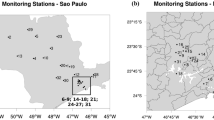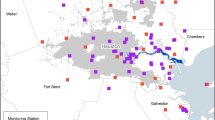Abstract
This study established a cause–effect relationship between ground-level ozone and latent variables employing partial least-squares analysis at an urban roadside site in four distinct seasons. Two multivariate analytic methods, factor analysis, and cluster analysis were adopted to cite and identify suitable latent variables from 14 observed variables (i.e., meteorological factors, wind and primary air pollutants) in 2008–2010. Analytical results showed that the first six components explained 80.3 % of the variance, and eigenvalues of the first four components were greater than 1. The effectiveness of this model was empirically confirmed with three indicators. Except for surface pressure, factor loadings of observed variables were 0.303–0.910 and reached statistical significance at the 5 % level. Composite reliabilities for latent variables were 0.672–0.812 and average variances were 0.404–0.547, except for latent variable “primary” in spring; thus, discriminant validity and convergent validity were marginally accepted. The developed model is suitable for the assessment of urban roadside surface ozone, considering interactions among meteorological factors, wind factors, and primary air pollutants in each season.






Similar content being viewed by others
References
Abdi, H. (2003). PLS-regression: multivariate analysis. Encyclopedia for research methods for the social sciences, Thousand Oaks, Sage, 1–7.
Abdul-Wahab, S. A., Bakheit, C. S., & Al-Alawi, S. M. (2005). Principal component and multiple regression analysis in modelling of ground-level ozone and factors affecting its concentrations. Environmental Modelling Software, 20, 1263–1271.
Al-Alawi, S. M., Abdul-Wahab, S. A., & Bakheit, C. S. (2008). Combining principal component regression and artificial neural networks for more accurate predictions of ground-level ozone. Environmental Modelling Software, 23, 396–403.
Arruti, A., & Fernández-Olmo, I. (2010). Evaluation of the contribution of local sources to trace metals levels in urban PM2.5 and PM10 in the Cantabria region. Journal of Environmental Monitoring, 12, 1451–1458.
Bagozzi, R. P., & Yi, Y. (1988). On the evaluation for structural equation models. Journal of the Academy of Marketing Science, 16, 74–94.
Baker, J. (2010). A cluster analysis of long range air transport pathways and associated pollutant concentrations within the UK. Atmospheric Environment, 44, 563–571.
Brankov, E., Rao, S. T., & Porter, P. S. (1988). A trajectory-cluster-correlation methodology for examining the long-range transport of air pollutants. Atmospheric Environment, 32, 1525–1534.
Camalier, L., Cox, W., & Dolwick, P. (2007). The effects of meteorology on ozone in urban areas and their use in assessing ozone trends. Atmospheric Environment, 41, 7127–7137.
Cape, J. N., Methven, J., & Hudson, L. E. (2000). The use of trajectory cluster analysis to interpret trace gas measurements at Mace Head. Ireland, Atmospheric Environment, 34, 3651–3663.
Chang, S. C., & Lee, C. T. (2008). Evaluation of the temporal variations of air quality in Taipei City, Taiwan, from 1994 to 2003. Journal of Environmental Management, 86, 627–635.
Coury, C., & Dillner, A. M. (2007). Trends and sources of particulate matter in the Superstition Wilderness using air trajectory and aerosol cluster analysis. Atmospheric Environment, 41, 9309–9323.
Diamantopoulos, A. D., & Siguaw, J. A. (2000). Introducing LISREL. London: Sage.
Dominick, D., Juahir, H., Latif, M. T., Zain, S. M., & Aris, A. Z. (2012). Spatial assessment of air quality patterns in Malaysia using multivariate analysis. Atmospheric Environment, 60, 172–181.
Dorling, S. R., Davies, T. D., & Pierce, C. E. (1992). Cluster analysis: a technique for estimating the synoptic meteorological controls on air and precipitation chemistry-method and applications. Atmospheric Environment, 26A, 2575–2581.
Eder, B. K. (1989). A principal component analysis of SO4 2− precipitation concentrations over the eastern United States. Atmospheric Environment, 23, 2739–2750.
Eder, B. K., Davis, J. M., & Bloomfield, P. (1993). A characterization of the spatiotemporal variability of non-urban ozone concentrations over the eastern United States. Atmospheric Environment, 27A, 2645–2668.
Fornell, C., & Larcker, D. F. (1981). Evaluating structural equation models with unobservable variables and measurement error. Journal of Marketing Research, 18, 39–50.
Gramsch, E., Cereceda-Balic, F., Oyola, P., & von Baer, D. (2006). Examination of pollution trends in Santiago de Chile with cluster analysis of PM10 and Ozone data. Atmospheric Environment, 40, 5464–5475.
Hair, J. F., Jr., Black, W. C., Babin, B. J., & Anderson, R. E. (2010). Multivariate data analysis: a global perspective. London: Pearson.
Henry, R. C., & Hidy, G. M. (1979). Multivariate analysis of particulate sulfate and other air quality variables by principal components-part I annual data from Los Angeles and New York. Atmospheric Environment, 13, 1581–1596.
Henry, R. C., & Hidy, G. M. (1982). Multivariate analysis of particulate sulfate and other air quality variables by principal components-part II Salt Lake City, Utah and ST. Louis, Missouri, Atmospheric Environment, 16, 929–943.
Holzworth, G. C. (1964). Estimates of mean maximum mixing depths in the contiguous United States. Monthly Weather Review, 92, 235–242.
Kaiser, H. F. (1958). The Varimax criterion for analytic rotation in factor analysis. Psychometrika, 23, 187–201.
Karaca, F., & Camci, F. (2010). Distant source contributions to PM10 profile evaluated by SOM based cluster analysis of air mass trajectory sets. Atmospheric Environment, 44, 892–899.
Lelieveld, J., & Crutzen, P. J. (1990). Influences of cloud photochemical processes on tropospheric ozone. Nature, 343, 227–233.
Lengyel, A., Héberger, K., Paksy, L., Bánhidi, O., & Rajkó, R. (2004). Prediction of ozone concentration in ambient air using multivariate methods. Chemosphere, 57, 889–896.
Lin, C. J., Ho, T. C., Chu, H. W., Yang, H., Chandru, S., Krishnarajanagar, N., Chiou, P., & Hopper, J. R. (2005). Sensitivity analysis of ground-level ozone concentration to emission changes in two urban regions of southeast Texas. Journal of Environmental Management, 75, 315–323.
Liu, P. W. G., Yao, Y. C., Tsai, J. H., Hsu, Y. C., Chang, L. P., & Chang, K. H. (2008). Source impacts by volatile organic compounds in an industrial city of southern Taiwan. Science of the Total Environment, 398, 154–163.
Özbay, B., Keskin, G. A., Doğruparmak, Ş. Ç., & Ayberk, S. (2011). Multivariate methods for ground-level ozone modeling. Atmospheric Research, 102, 57–65.
Pires, J. C. M., Sousa, S. I. V., Pereira, M. C., Alvim-Ferraz, M. C. M., & Martins, F. G. (2008a). Management of air quality monitoring using principal component and cluster analysis—Part I: SO2 and PM10. Atmospheric Environment, 42, 1249–1260.
Pires, J. C. M., Sousa, S. I. V., Pereira, M. C., Alvim-Ferraz, M. C. M., & Martins, F. G. (2008b). Management of air quality monitoring using principal component and cluster analysis—Part II: CO, NO2 and O3. Atmospheric Environment, 42, 1261–1274.
Ringle, C. M., Wende, S., & Will, S. (2005). SmartPLS 2.0 (M3) Beta. Hamburg: University of Hamburg.
Rodriguez, N. G., Perez, M. J., & Gutierrez, J. A. T. (2007). Interfunctional trust as a determining factor of a new product performance. European Journal of Marketing, 41, 678–702.
Saksena, S., Joshi, V., & Patil, R. S. (2003). Cluster analysis of Delhi's ambient air quality data. Journal of Environmental Monitoring, 5, 491–499.
Seinfeld, J. H. (1986). Atmospheric chemistry and physics of air pollution. New York: Wiley.
Singh, K. P., Malik, A., Basant, N., & Saxena, P. (2007). Multi-way partial least squares modeling of water quality data. Analytica Chimica Acta, 584, 385–396.
Statheropopulos, M., Vassiliadis, N., & Papps, A. (1988). Principal component and canonical correlation analysis for examining air pollution and meteorological data. Atmospheric Environment, 32, 1087–1095.
Wold, S. (2001). PLS-regression: a basic tool of chemometrics. Chemometrics and Intelligent Laboratory Systems, Chemometrics and Intelligent Laboratory Systems, 58, 109–622.
Yeganeh, B., Motlagh, M. S. P., Rashidi, Y., & Kamalan, H. (2012). Prediction of CO concentrations based on a hybrid partial least square and support vector machine model. Atmospheric Environment, 55, 357–365.
Yu, T. Y. (2010). Characterization of ambient PM2.5 concentrations. Atmospheric Environment, 44, 2902–2912.
Yu, T. Y. (2012). Characterization of ambient air quality during a rice straw burning episode. Journal of Environmental Monitoring, 14, 817–829.
Zhou, L., Hopke, P. K., Stanier, C. O., Pandis, S. N., Ondov, J. M., & Pancras, J. P. (2005). Investigation of the relationship between chemical composition and size distribution of airborne particles by partial least squares and positive matrix factorization, Journal of Geophysical Research, 110, D07S18, 14 PP
Author information
Authors and Affiliations
Corresponding author
Rights and permissions
About this article
Cite this article
Lin, KM., Yu, TY. & Chang, LF. Establishment of a structural equation model for ground-level ozone: a case study at an urban roadside site. Environ Monit Assess 186, 8317–8328 (2014). https://doi.org/10.1007/s10661-014-4005-1
Received:
Accepted:
Published:
Issue Date:
DOI: https://doi.org/10.1007/s10661-014-4005-1




